 An Attempt of Creating Sound Pathway for Guiding Visually-Impaired People in Snow Regions An Attempt of Creating Sound Pathway for Guiding Visually-Impaired People in Snow Regions |
<Proceedings of the 45th Annual Conference of Environmental Design Research Association, p. 421, May. 2014. >
|
| Nana Fukuda, Ryuzo Ohno |
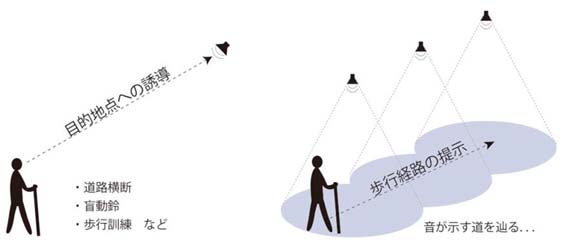 |
An outdoor experiment with nine visually impaired people was conducted
to investigate the navigational effect of sound cues. Loudspeakers were
placed at a height of 3111. pointing vertically toward the ground at 10111
intervals. Experimental stimuli were birds‘ tweet and the sound of a creek.
These stimuli were used individually or mixed in three different conditions.
It was revealed that the visually impaired tend to use birdsf tweet to
check for the direction while a creek sound for the localization. l\‘Iore0ver.
subjects were able to pick up the timbre change caused by coloration as
well as volume change of the continuous sound as clues.
Full paper in Japanese->PDF part1、 part2、 part3 |
|
 The effect of the outdoor environment on outings by mothers with small children The effect of the outdoor environment on outings by mothers with small children
<Proceedings 22nd International Conference of the IAPS, p. 232, June
2012.>
Ohno, R., Oshiumi, Y., Yin, Q. |
The increasing nuclearization of Japanese urban families has left young
homemaking mothers often feeling isolated and vulnerable to the stresses
of childrearing. Many of these parents welcome venturing from the house
for some diversion and social interaction, making it doubly important for
society to create outdoor environments that support going out with small
children.
The present study discusses a questionnaire survey comparing young mothers’
habitual outings in four Tokyo neighborhoods?one long-established and one
newly developed residential area each from the largely white-collar yamanote
district to the west and the traditionally more commercial shitamachi district
to the east. Respondents set down destinations, purposes, time required,
and means of travel on a time sequence chart and recorded routes on a map.
In all areas, the most popular destinations were the supermarket and city
park. Residents of the new neighborhoods, however, headed to larger parks
and shopping complexes, while in the older shitamachi neighborhood, respondents
frequently patronized small shopping streets where they could enjoy talking
with shopkeepers. Routes were typically selected according to functional
considerations such as traffic safety and smoothness of the paving, a concern
particularly for stroller users. Wide sidewalks were preferred because
the mothers could walk side by side with friends while chatting. At the
same time, recreational criteria were also cited, including the presence
of roadside greenery, running water, or objects and people stimulating
to the children. The older neighborhoods had more routes satisfying recreational
needs than the newly developed ones, which in turn were better at answering
functional needs.
The results highlight that attempts to design outdoor environments for
parents with small children need to address not only safety and accessibility,
but also the demand for stimulation and company.
Full paper -> PDF(IAPS2012) |
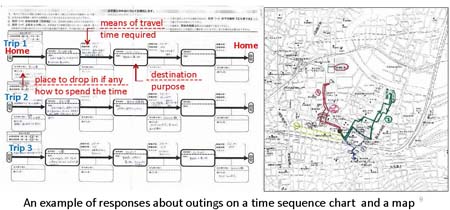
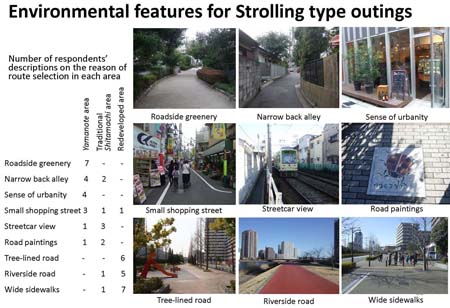 |
|
 Situations that Cause Pregnant Women to Feel Unsafe near Other Pedestrians: a Quantitative Analysis Situations that Cause Pregnant Women to Feel Unsafe near Other Pedestrians: a Quantitative Analysis |
<The 7th International Symposium on Environment-behavior Research (EBRA2006),
Dalian, China, October, 2006 >
Ryuzo Ohno, Yuki Takayama and Masashi Soeda |
|
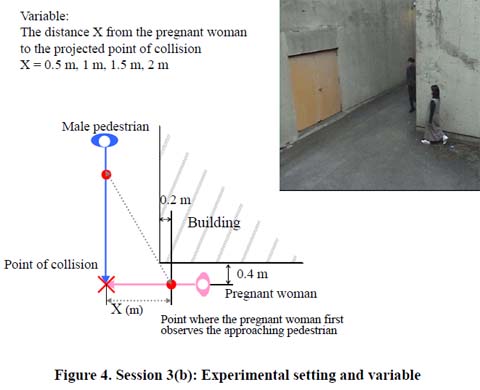 |
Pregnant women often feel uneasy when they go through spaces crowded with
pedestrians. They tend to avoid going out to town out of the worry that
they might bump against others and cause serious physical damage to themselves
and the unborn baby. This study examines the functional relationships between
pregnant women’s feelings of danger and several potentially influential
situational factors as a step toward developing designs for public spaces
that are safe and comfortable for pregnant women.
Full paper -> PDF |
|
 Perception of Earthquake Hazard by Urban Children Perception of Earthquake Hazard by Urban Children |
<Second International Conference on Urban Earthquake Engineering, Center
for Urban Earthquake Engineering (CUEE), 2005>
Megumi Katayama, Ryuzo Ohno, Masashi Soeda, Shima Nara |
| Full paper -> PDF |
|
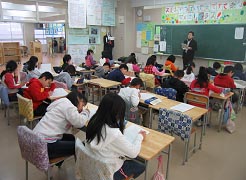
|
|
The purpose of this study is to investigate how children perceive earthquake hazard,
especially focusing on the influence of their image toward earthquakes, knowledge of
activities that can reduce the damages. The survey was conducted with primary school
children and their parents. As results following influential factors are revealed. Age:
Children tend to perceive risks and damages of earthquake hazards more serious than adults,
however they are more optimistic about confidence in own behavior during earthquake and
satisfied with their parents' preparedness at their home. Girls pay more attention to the
physical damage while adult females concern more about the sufferers' post-disaster living
conditions. Gender: Girls have lesser confidence in own behavior during earthquake, and
evaluate their parents' preparedness lower than boys. Housing structure: People living in
wooden houses anticipate the damage severer than those in other types of houses. Area of
living: Adults in Akashi city anticipate the probability of a grate earthquake occurrence
lower than those in Yokohama city, and this may suggest that an earthquake experience has
an effect to pay less attention to its occurrence. Communication at home: Children who do
not talk with their parents about disaster prevention seem to feel helpless and have passive
attitude to the earthquake hazard.
|
 The Effects of the Presentation Methods upon Client’s Implications of their Desire for Living Rooms The Effects of the Presentation Methods upon Client’s Implications of their Desire for Living Rooms |
<Journal of Archit. Plann. Environ. Eng., AIJ, No 555, pp.137-143 May,
2002>
Shigeo Kobayashi, Masumi Kawada, Ryuzo Ohno |
|
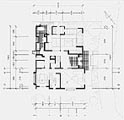  
|
|
Part1: Information and Latent Desire
Evoked by Presentation
This study intends to show what methods of presentation can draw out the
client’s latent desire. A series of interviews were conducted in person.
First, subjects were asked to talk freely of their desires for the living room.
Secondly, they were presented three different living rooms, each by three
different methods: architectural drawings, perspectives, and a scale model.
Finally, they visited real living rooms. The subjects were asked to state their
desire after each presentation. The words used by the subjects were classified
into two categories with which the characteristics of each presentation mean
were clarified. The
result of the experiment indicated that there were two different types of
response: one subject’s group changed their attitude according to the means of
presentation and the other remained unchanged. Therefore, architects should
consider these differences to draw the client’s latent desire
|
goto TOP
|